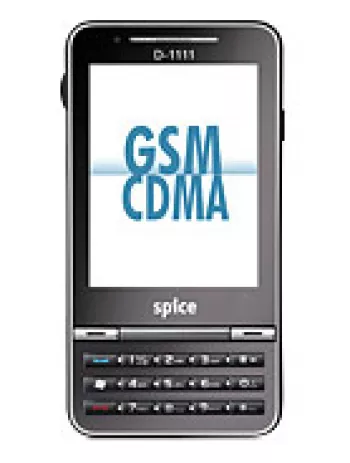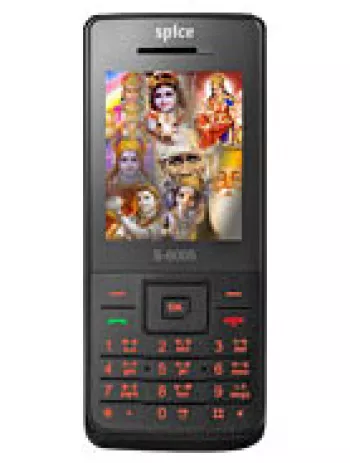
Overview of Spice D-1111
The Spice D-1111 is a smartphone that was announced and released in 2010, a time when mobile technology was evolving rapidly. At its core, the D-1111 was designed to offer basic smartphone capabilities at a competitive price. Despite being discontinued, it holds a special place for users who wanted affordable access to smartphone features during its time.
Body and Design
The Spice D-1111 measures 110.8 x 58.3 x 16.8 mm and weighs 130.2 g, making it a fairly compact device compared to modern standards. The phone was designed with practicality in mind, featuring a Mini-SIM slot that was typical of devices released during that period. Its weight and dimensions made it easy to hold and use with one hand, adding to the user convenience.
Display Characteristics
Sporting a 2.8-inch TFT resistive touchscreen, the Spice D-1111 offered a display size that was quite common in early 2010s smartphones. The screen, with a resolution of 240 x 320 pixels, provided a pixel density of approximately 143 ppi, which was adequate for basic tasks such as viewing messages and navigating the interface. The screen-to-body ratio of around 37.6% reflects the design trend of the era, where bezels were prominently visible.
Platform and Operating System
Running on Microsoft Windows Mobile 6.0, the device was part of the range of smartphones using Microsoft's early mobile operating system. Although not as feature-rich as modern operating systems, Windows Mobile 6.0 provided essential functionality such as email, web browsing, and calendar management, catering to business users and those needing basic smartphone capabilities.
Network and Connectivity
The Spice D-1111 supports GSM and CDMA2000 technologies, which are suitable for 2G and basic 3G connectivity. This allowed for communication over a range of networks, an important feature at a time when network technology was transitioning. The device offered speeds up to 384 kbps, sufficient for basic internet browsing and downloading emails. However, modern Wi-Fi capabilities were absent, reflecting the technological limitations of the period.
Camera Capabilities
The D-1111 is equipped with a 2 MP primary camera, capable of capturing basic photos and videos. While this may seem limited by today’s standards, it was suitable for capturing everyday moments and provided users with an entry point into mobile photography.
Storage and Memory
Internally, the phone features 60MB of storage, which can be expanded using the microSDHC slot. This allowed users to store contact information, messages, and basic multimedia files. While the internal storage may feel restrictive now, the expandability via microSD cards offered flexibility to users who required additional space for apps and files.
Battery Life
Powered by a removable Li-Ion 1350 mAh battery, the Spice D-1111 provided a respectable battery life for its era. With a standby time of up to 120 hours and a talk time of around 8 hours, the phone met the needs of users looking for reliable battery performance for everyday use.
Audio and Comms Features
While the device includes a loudspeaker for calls and media playback, it notably lacks a 3.5mm headphone jack, a surprising omission given its prevalence in devices from the same period. Bluetooth 1.2 support allowed for basic wireless audio connections and data transfer, though it was limited compared to later versions.
Price and Market Positioning
Priced at approximately 90 EUR, the Spice D-1111 was positioned as a budget-friendly option for consumers seeking basic smartphone functions. This made it accessible to a broader audience during its release, contributing to its popularity among budget-conscious buyers.
Conclusion
In retrospective, the Spice D-1111 represented an intersection of affordability and basic functionality during the early 2010s. While it lacks many features that modern consumers expect, it served as a stepping stone for many into the world of smartphones. The device's straightforward design and essential smartphone capabilities illustrate the evolution of mobile technology and provide a reference point for how far smartphones have come since then.
Spice D-1111 Key Features
- Supports GSM and CDMA2000 technologies.
- Available 3G connectivity with up to 384 kbps speed.
- Compact design with dimensions: 110.8 x 58.3 x 16.8 mm.
- Lightweight at 130.2 grams.
- Features a 2.8-inch TFT resistive touchscreen display.
- Runs on Microsoft Windows Mobile 6.0 OS.
- Expandable storage via microSDHC card slot.
- Equipped with a 2 MP main camera.
- Offers Bluetooth 1.2 with A2DP support.
- Removable Li-Ion 1350 mAh battery with up to 8 hours talk time.
- Affordable pricing at around 90 EUR.
Spice D-1111 Disadvantages
- Discontinued model, no longer supported by manufacturer.
- Runs on the outdated Microsoft Windows Mobile 6.0 OS.
- Limited internal storage of only 60MB.
- Small 2.8-inch TFT resistive touchscreen with low resolution (240 x 320 pixels).
- Lacks modern connectivity options such as WLAN and 3.5mm headphone jack.
- No GPS positioning or FM radio support.
- Low camera capability with a single 2 MP rear camera and no front-facing camera.
- Uses a proprietary USB connection instead of standard microUSB or USB-C.
- Limited Bluetooth version (1.2) compared to newer devices.
View Also
More Phones
All Rights Reserved +14266 Phones © Mobilawy 2025

























